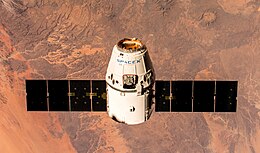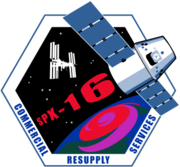 CRS-16 Dragon approaching the ISS CRS-16 Dragon approaching the ISS | |
| Names | SpX-16 |
|---|---|
| Mission type | ISS resupply |
| Operator | SpaceX |
| COSPAR ID | 2018-101A |
| SATCAT no. | 43827 |
| Mission duration | 39 days, 10 hours, 54 minutes |
| Spacecraft properties | |
| Spacecraft | Dragon 1 C112 |
| Spacecraft type | Dragon 1 |
| Manufacturer | SpaceX |
| Dry mass | 4,200 kg (9,300 lb) |
| Dimensions | Height: 6.1 m (20 ft) Diameter: 3.7 m (12 ft) |
| Start of mission | |
| Launch date | 5 December 2018, 18:16:00 UTC |
| Rocket | Falcon 9 Block 5 (B1050) |
| Launch site | Cape Canaveral, SLC-40 |
| End of mission | |
| Disposal | Recovered |
| Landing date | 14 January 2019, 05:10 UTC |
| Landing site | Pacific Ocean off Baja California |
| Orbital parameters | |
| Reference system | Geocentric orbit |
| Regime | Low Earth orbit |
| Inclination | 51.6° |
| Berthing at ISS | |
| Berthing port | Harmony nadir |
| RMS capture | 8 December 2018, 12:21 UTC |
| Berthing date | 8 December 2018, 15:36 UTC |
| Unberthing date | 13 January 2019, 20:00 UTC |
| RMS release | 13 January 2019, 23:33 UTC |
| Time berthed | 36 days, 4 hours, 24 minutes |
| Cargo | |
| Mass | 2,573 kg (5,672 lb) |
| Pressurised | 1,598 kg (3,523 lb) |
| Unpressurised | 975 kg (2,150 lb) |
 NASA SpX-16 mission patch Commercial Resupply Services← NG-10NG-11 → Cargo Dragon← SpaceX CRS-15SpaceX CRS-17 → | |
SpaceX CRS-16, also known as SpX-16, was a Commercial Resupply Service mission to the International Space Station launched on 5 December 2018 aboard a Falcon 9 launch vehicle. The mission was contracted by NASA and is flown by SpaceX.
This CRS mission was the first to be launched by the Falcon 9 Block 5. It carried the Global Ecosystem Dynamics Investigation (GEDI) lidar and the Robotic Refueling Mission 3 (RRM3) experiment as external payloads.
Launch
In February 2016, it was announced that NASA had awarded a contract extension to SpaceX for five additional CRS missions (CRS-16 to CRS-20). In June 2016, a NASA Inspector General report had this mission manifested in August 2018, but it was later delayed to 29 November 2018, 4 December 2018, and 5 December 2018.
The first stage booster B1050.1 experienced a grid fin hydraulic pump stall on re-entry. This caused the first stage to go into a roll after the re-entry burn. It failed to reach Landing Zone 1, but recovered enough to achieve a water landing off Cape Canaveral. Shortly after the landing, Elon Musk, CEO of SpaceX, stated the booster appeared undamaged and was being recovered. After recovering the booster, it was found to be too damaged to fly again and was scrapped for parts.
On 13 January 2019, Dragon was released from ISS at 23:33 UTC and deorbited, splashing down in the Pacific Ocean approximately 5 hours later on 14 January 2019 at 05:10 UTC, returning more than 2,500 kg (5,500 lb) of cargo to Earth.
Payload
NASA had contracted for the CRS-16 mission from SpaceX and therefore determined the primary payload, date/time of launch, and orbital parameters for the Dragon space capsule. CRS-16 carried a total of 2,573 kg (5,672 lb) of material into orbit. This included 1,598 kg (3,523 lb) of pressurised cargo with packaging bound for the International Space Station, and 975 kg (2,150 lb) of unpressurised cargo composed of two external station experiments: the Global Ecosystem Dynamics Investigation (GEDI) lidar and the Robotic Refueling Mission 3. Forty mice also flew with the payload in an experiment called Rodent Research-8 (RR-8).
The CRS-16 mission also carried a pair of CubeSats originally planned to launch aboard the Cygnus NG-10 International Space Station (ISS) cargo resupply mission, but which were deferred. These included the UNITE CubeSat from the University of Southern Indiana and the TechEdSat-8 CubeSat from NASA's Ames Research Center.
The following is a breakdown of cargo bound for the ISS:
- Crew supplies: 304 kg (670 lb)
- Science investigations: 1,037 kg (2,286 lb)
- Rodent Research-8 (RR-8)
- Molecular Muscle Experiment (MME)
- Growth of Large, Perfect Protein Crystals for Neutron Crystallography (Perfect Crystals)
- Spacewalk equipment: 15 kg (33 lb)
- Vehicle hardware: 191 kg (421 lb)
- Computer resources: 40 kg (88 lb)
- Russian hardware: 11 kg (24 lb)
- External payloads:
- Global Ecosystem Dynamics Investigation (GEDI): ≈500 kg (1,100 lb)
- Robotic Refueling Mission 3 (RRM3)
Gallery
SpaceX CRS-16See also
References
- ^ Bergin, Chris (14 January 2019). "CRS-16 Dragon returns to Earth following ISS departure". Spaceflight Now. Retrieved 21 January 2019.
- "Dragon in the Grips of Robotic Arm, Installation Occurs Next". NASA. 8 December 2018. Retrieved 8 December 2018.
 This article incorporates text from this source, which is in the public domain.
This article incorporates text from this source, which is in the public domain.
- Gebhardt, Chris (8 December 2018). "Dragon brings the science; NASA, SpaceX realign DM-1 test to NET 17 January launch". NASASpaceFlight.com. Retrieved 8 December 2018.
- Garcia, Mark. "Dragon Attached to Station, Returns to Earth in January". NASA. Archived from the original on 14 December 2018. Retrieved 8 December 2018.
 This article incorporates text from this source, which is in the public domain.
This article incorporates text from this source, which is in the public domain.
- Richardson, Derek (13 January 2019). "CRS-16 unberthing, splashdown". Orbital Velocity. Archived from the original on 19 April 2019. Retrieved 12 August 2020.
- Richardson, Derek (14 January 2019). "SpaceX Completes 16th Dragon Mission to ISS". Spaceflight Insider. Retrieved 12 August 2020.
- Lewin, Sarah (5 December 2018). "SpaceX Launches Dragon Cargo Ship to Space Station, But Misses Rocket Landing". Space.com. Retrieved 15 December 2018.
- ^ Pietrobon, Steven (1 November 2018). "United States Commercial LV Launch Manifest". Retrieved 1 November 2018.
- de Selding, Peter B. (24 February 2016). "SpaceX wins 5 new space station cargo missions in NASA contract estimated at $700 million". SpaceNews. Retrieved 24 February 2016.
- NASA Office of Inspector General (28 June 2016). NASA's Response to SpaceX's June 2015 Launch Failure: Impacts on Commercial Resupply of the International Space Station (PDF) (Report). NASA Office of Inspector General. p. 13. Retrieved 18 July 2016.
 This article incorporates text from this source, which is in the public domain.
This article incorporates text from this source, which is in the public domain.
- "Launch Schedule". Spaceflight Now. 31 May 2018. Archived from the original on 1 June 2018.
- ^ Wall, Mike (4 December 2018). "Moldy Mouse Chow Delays SpaceX Dragon Launch to Space Station". Space.com.
- Thompson, Amy (20 December 2018). "A SpaceX Booster Went for a Swim and Came Back as Scrap Metal". Wired. Retrieved 12 January 2021.
- Platnick, Steve (May–June 2018). "Editor's Corner" (PDF). The Earth Observer. 30 (3). NASA/GSFC: 3.
 This article incorporates text from this source, which is in the public domain.
This article incorporates text from this source, which is in the public domain.
- Richardson, Derek (5 March 2019). "ISS Astronauts Assemble Tools for Robotic Refueling Demo". Spaceflight Insider. Retrieved 12 August 2020.
- Graham, William (5 December 2018). "Falcon 9 successfully lofts CRS-16 Dragon enroute to ISS – Booster spins out but soft lands in water". NASASpaceFlight.com. Retrieved 6 December 2018.
- "SpaceX CRS-16 Mission Overview" (PDF). NASA. Retrieved 20 April 2019.
 This article incorporates text from this source, which is in the public domain.
This article incorporates text from this source, which is in the public domain.
- "Rodent Research-8". NASA/Space Station Research Explorer. Retrieved 12 August 2020.
 This article incorporates text from this source, which is in the public domain.
This article incorporates text from this source, which is in the public domain.
- Bartels, Meghan (28 September 2018). "Thousands of Worms Are Launching Into Space Soon. You Know... for Science". Space.com. Retrieved 12 August 2020.
- Plain, Charlie (19 December 2018). "Crystal Clear: Finding Ways to Protect Crews from the Effects of Space Radiation". NASA. Retrieved 12 August 2020.
 This article incorporates text from this source, which is in the public domain.
This article incorporates text from this source, which is in the public domain.
- Nevres, M. Özgür (2 May 2019). "GEDI: NASA's Laser Mission to Measure Trees". Our Planet. Retrieved 12 August 2020.
External links
- Dragon website at SpaceX.com
- Commercial Resupply Services at NASA.gov
| SpaceX Dragon 1 and Dragon 2 | |||||||
|---|---|---|---|---|---|---|---|
| Spacecraft |   | ||||||
| Hardware | |||||||
| Missions |
| ||||||
| |||||||
| SpaceX missions and payloads | |||||||||||||||||||||
|---|---|---|---|---|---|---|---|---|---|---|---|---|---|---|---|---|---|---|---|---|---|
| Launch vehicles | |||||||||||||||||||||
| Falcon 1 missions |
| ||||||||||||||||||||
| Falcon 9 missions |
| ||||||||||||||||||||
| Falcon Heavy missions |
| ||||||||||||||||||||
| Starship missions |
| ||||||||||||||||||||
| |||||||||||||||||||||
| Uncrewed spaceflights to the International Space Station | ||
|---|---|---|
| ||
| 2000–2004 |  | |
| 2005–2009 | ||
| 2010–2014 | ||
| 2015–2019 | ||
| 2020–2024 | ||
| Future | ||
| Spacecraft | ||
| ||


